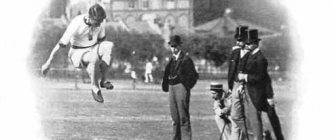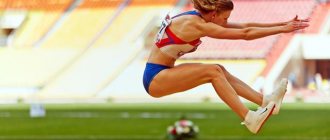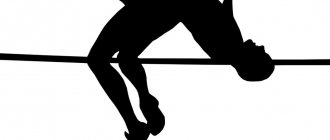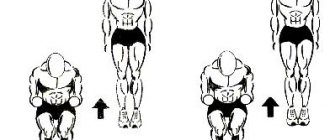Task 1. Teach take-off in long jumps
Means: jumping with one take-off step; jump “in step”, i.e. make a fixed step position in flight, with 2-3 running steps running through the fly leg upon landing; jump “in step” with 4-6 running steps of the take-off run through the fly leg upon landing; jump “in step” from 2-3 running steps with a landing in a lunge position; long jump with 3-4 running steps over a low obstacle.
Methodical instructions: push-off should be performed from an arbitrary place, placing the foot on the track with its active lowering, almost straightened in all joints. Make sure to maintain a vertical position of the body, observe the swing movement of the free leg, bending at the knee joint, and vigorously straighten the whole body upward and forward. The last step of the run-up is performed faster than the previous ones.
Landing
The effectiveness of this phase of the jump is largely determined by the nature of the formation at the end of the flight. Raising the knees high forward and upward towards a bent torso with slightly bent arms moving forward, down and back allows the athlete to expend less effort to hold the legs when throwing them forward.
After grouping, the jumper brings his feet forward, straightens his torso and moves his pelvis forward. Before touching the sand, the legs are practically straightened at the knee joints, and the toes are “taken over.” Both feet land on the same line. After the feet touch the sand, the body moves in a straight line, which is facilitated by swinging the arms forward, or it falls to the side of it.
Task 2. Teach the combination of run-up and take-off
Means: multiple jumps simulating walking out at different speeds; running along the runway 6-8 running steps with a push-off designation; long jump with 3-5 running steps with a gradual increase in speed; long jump with a medium run-up.
Methodical instructions: when running, give preference to a uniform increase in speed to a level that allows you to control movements during the entire exercise. Monitor the gradual increase in the pace of running steps. When placing your foot to take off, perform it with a running “raking” movement in front of you. Minimize preparation for take-off, which is expressed in a slight squat on the swing leg and maintaining active movement in the last step of the run.
Number of attempts and result measurement
Athletes perform each attempt in turn (6 attempts in total). No more than one and a half minutes are allotted to perform each jump. The winner is determined by the best result shown by him from all six attempts. The result is measured using a tape measure. The zero mark is set at the point closest to the block that was left by any part of the athlete’s body in the sand pit. The result is calculated in whole centimeters, with rounding downwards.
Let us highlight the cases in which the jump is not counted:
1) if the participant ran from the side of the bar or through it;
2) if he stepped on the measurement line with his foot;
3) if the athlete pushes off with both legs;
4) if he touched the ground to the pit during the jump;
5) if the jumper used a somersault in the jump.
Task 3. Teach movements in flight
Legs bent method
Means: imitation of the flight phase - jumping up from a place with two legs with active pulling of the knees to the chest; imitation of the flight phase - in a shallow lunge position, the swing leg in front. Pull the push leg towards the fly leg; long jump using the “legs bent” method while walking; long jump using the “legs bent” method with a short run-up; long jumps using the “legs bent” method from different run-ups.
Methodical instructions: pay attention to the almost vertical position of the body in the flight phase, actively pulling up the knees when tucked before landing.
The “bend over” method
Means: imitation of the flight phase - jump up from a place with two legs with a slight movement of the pelvis forward, slight deflection of the torso and lifting of the legs from behind; long jump using the “bend over” method from walking; long jump using the “bend over” method from a short run-up (possibly from a slight elevation); long jump using the “bend over” method from different run-ups.
Methodical instructions: perform bending of the body without a sudden movement of the pelvis forward, ensure that freedom of movement is maintained during the flight phase.
Scissors method
Means: imitation of the flight phase - jumping up from a place on one leg with an attempt to perform running movements in flight, followed by landing on both legs; long jump with several running steps with the fly leg running during landing; long jump with several running steps running through the take-off leg upon landing; long jump from a short run-up with changing the position of the legs in flight and landing on both legs in the “lunge” position (the pushing leg is in front); long jump with a short run-up using the scissor method from a small elevation; long jump from various run-ups using the scissors method.
Methodological instructions: do not delay holding the “in step” position in the flight phase, which negatively affects the timeliness of lowering the fly leg down. Changing the position of the legs in flight should correspond to the running movements and be consistent with the work of the arms.
Features of standing jumps
Classic standing long jump is an independent type of competition when passing physical education standards at school. They are also often included in track and field all-around programs or are a separate exercise for harmonious athletic development. Having mastered how to do a standing long jump, you will be able to develop speed and strength qualities, jumping ability, and sprinting skills.
Before analyzing the standing jumping technique, you need to understand a little about what kind of exercise it is. Since school, we know that this exercise is performed by simultaneously lifting off the surface of the legs, and the goal of the jumper is to cover the maximum distance in flight. Having reached contact with the ground, the jumper straightens up and leaves the landing zone. The length of the jump is then measured. This is done along the perpendicular between the extreme lift-off point and the landing. The point of contact in this case is the closest place of landing by any part of the body. There are standards that allow you to objectively assess the physical fitness of a jumper:
- For schoolchildren 8-10 years old, the norm is 120-160 cm.
- Schoolchildren 11-15 years old – 150-200 centimeters.
- For boys and men aged 16-30 years – 200-240 cm.
For female representatives, these same standards are reduced by 10%.
Age categories remain the same. Now let's take a closer look at the step-by-step technique of how to properly perform a standing long jump.
Preparing for the jump
The initial stage, which involves accepting the starting position. It is quite important, as it determines the strength of the push and the overall result of the jump. To take the correct position, the following actions are required:
- You need to stand at the starting line.
- Your legs should be positioned at shoulder level.
- Lower your arms down and move them back a little. Bend your elbows so that you can push your body forward.
- Place your legs on the entire foot.
- Bend your knees and hips so that they are level with your toes.
Repulsion
This stage is performed immediately after the previous one, without stopping, when the body is still moving downward by inertia, and the hip joints begin to unbend. The arms are thrown forward in the direction of the jump. The second phase of the exercise is performed as follows:
- Hands are thrown forward sharply.
- The hip joints are pulled forward.
- The knee joints are extended.
- With an explosive movement, the feet lift off the ground.
Flight and landing
When the athlete is in the air, he pulls his knee joints towards his chest and extends his body in a straight line. At the end of the flight stage, the arms are lowered and the feet are brought forward. Then contact with the ground occurs and the jumper lands. During flight and landing the following movements are made:
- When contacting the surface, you need to bring your hands forward to make it easier to maintain balance.
- The knees bend to ensure a firm landing. At the same time, the load on joints and ligaments is reduced.
- When landing, the athlete needs to straighten up and leave the exercise area.
To perform a good standing long jump, do not land with your legs straight as this can cause injury to your knee joints. It is also important to first work through the above stages separately, and only then proceed directly to full-fledged jumps.
Task 5. Teach how to determine the length and rhythm of a full run-up
Means: running in a sector with 2-3 speed increases, simulating running towards the take-off point; run-up with 5-6 or 7-8 running steps with a push-off designation, maintaining a straight line of speed; running segments in the jumping sector in order to determine the full run-up.
Methodical instructions: the amount of run-up is determined by the speed capabilities of the athletes. The main criterion in the nature of the speed gain for beginners is the ability to evenly increase the speed until the moment of repulsion. Pay attention to the leading value at the end of the run-up of the tempo of movements.
Takeoff run
Currently, leading jumpers use a run-up length of 36 to 44 m (18-24 running steps). The length of the takeoff run is determined by a number of factors: gender, height indicators, and the degree of preparedness of special physical qualities.
At the end of the run (the last 6-4 running steps), the length and pace reach their maximum values. This allows you to acquire a speed at the end of the takeoff run of up to 11.0 m/s and begin the flight phase at a speed of up to 9.7 m/s. It is in this section of the run that one can obtain an objective indicator of the rhythmic structure of the jump, based on the distance and time of the last 6-4 running steps. An equally important indicator of the rhythmic structure should be considered the difference between the length of the last and penultimate step, which should not exceed 3/4 of the length of the foot. This indicator indicates the athlete’s development of maximum speed of movement before take-off.
Task 6. Improve the technique of movements in long jumps
Means: running in the rhythm of a run-up without or with a push-off designation; long jump with a short run-up in a mastered manner; long jump from a medium run-up in a mastered manner; long jump with a full run-up in a mastered manner.
Methodological instructions: evaluate and analyze the movements performed by the teacher and the student. The rhythm of the jump should be based on the ability to run to the place of take-off by increasing the tempo of running steps. The position of the torso at the end of the run-up and during the take-off should be vertical.
Fundamentals of athletics jumping technique[edit | edit code]
Athletics jumps belong to a group of exercises of a cyclic-acyclic (speed-strength) nature, the goal of which is to overcome the greatest horizontal or vertical space. Based on this, in accordance with motor tasks, long jump and triple jump (horizontal jumps) can be conditionally combined into one group, and high jumps and pole jumps (vertical jumps) into another group.
Sports result in athletics jumping[edit | edit code]
Range
and
the altitude of the flight trajectory of the athlete's GCMT
are determined by the take-off speed (V0), departure angle (a) and the height of the GCMT in the initial position, and the sports result is also determined by the landing technique in long jumps, the technique of crossing the bar in high jumps and pole vaults.
The range (5) and altitude (H) of the flight path of the OCMT can be approximately calculated using the following formulas
:
S=(V20Xsin2a)/g (I) and H=(V20xsin2a)/2g + h (II),
where S is the length and H is the height of the GCMT trajectory (without taking into account its height at the time of departure and landing), V is the initial velocity of the GCMT in flight, a is the angle of the horizontal velocity vector at the moment of departure, g is the acceleration of a freely falling body, h is the height OCMT at the end of the push-off.
From the formulas it is clear that performance in all types of jumps is directly dependent on the square of the initial take-off speed of the body and on the sin of take-off angle
(double in distance jumps), since the acceleration of gravity (g) is a constant value and is not subject to arbitrary regulation.
The initial speed of departure of the GCMT (V0)
is the speed with which the jumper leaves the track and which is formed as a result of the interaction of the jumper with the support. In this case, a vertical speed is created, a change in the magnitude and direction of the horizontal speed, due to which these two speeds, summed up, create the initial (resulting) speed of the body's departure.
The values of horizontal and vertical speeds in each type of jump must be optimal, based on the corresponding motor tasks. So, in high jumps, the horizontal speed reaches 7-7.5 m/s or more. Therefore, at a relatively low horizontal speed, conditions are created for greater upward repulsion in order to ensure the ability to overcome the bar at a high height. In long jumps, the horizontal take-off speed reaches more than 10 m/s, and the vertical take-off speed reaches more than 3 m/s.
Therefore, with high horizontal and sufficient vertical speed, the jumper manages to fly a significant distance.
The next value on which the result of the jump depends is the take-off angle, which is determined using a tangent to the flight path at the take-off point or by adding the velocity vectors acquired during the run-up (V1) and take-off (V2). As a result of the addition, the initial flight speed (V0) is obtained, the direction of which with the horizontal forms the departure angle a
(Fig. 5).
3) and take-off angle (a) in the high jump (A) and long jump (B)
The launch angle should not be confused with the take-off angle, which is characterized by the direction of the push at the final moment of take-off. Repulsion angle (β)
- the angle formed by the horizontal and the straight line connecting the athlete’s center of gravity and the take-off point.
Sometimes, for the convenience of practical analysis, it is determined by the inclination of the axis of the pushing leg to the horizontal. In high jumps (Fig. 5, A), the take-off angle approaches 90°, and the take-off angle approaches 60-70°. In long jump (B) the take-off angle is 70-80°, and the take-off angle is 16-25°.
These angles are interconnected with the values of horizontal and vertical speed with the technique of pre-push steps, with placing the foot on the ground before pushing off. During the flight phase, the jumper moves in space by inertia due to the speed obtained during the run-up and push, while experiencing the effects of gravity and environmental resistance. Gravity changes the vertical speed and direction of movement; environmental resistance reduces flight speed. The jumper's center of gravity in flight moves along a certain trajectory shaped like a parabola. This trajectory depends on the departure angle, the initial departure speed and the resistance of the medium. The resistance force of the medium (air) plays a big role at significant speeds in long and triple jumps. According to rough estimates, with a jump length of about 8 m, it reduces the result by 13 cm.
According to the laws of mechanics, relating to a body thrown into space at a certain angle, in flight no internal forces can change the flight path of the athlete’s GCMT
. All this fully applies to athletics jumps. Any movements in flight can only occur relative to the center of gravity. Therefore, in order for the jump to be more effective, it is necessary to achieve the highest speed of departure of the athlete’s GCMT and direct the flight path at the most favorable angle.
Parts of jump length and height[edit | edit code]
Rice.
6. Long jump using the “legs bent” method: L1, L2,13 - components of the jump length Actual jump length (L)
, which may differ from the result recorded in competitions due to inaccuracy in hitting the take-off place, is the sum of three segments characterizing the length of the jump (Fig. 6):
- the distance from the toe of the pushing leg to the projection onto the horizontal plane of the athlete’s center of gravity at the moment of completion of the push-off (L1);
- the distance covered by the center of gravity during the flight (until the moment the feet first touch the sand) (L2);
- the distance from the GCMT projection onto the horizontal plane at the moment of touching the sand to the landing site (L3).
Moreover, the contribution of these segments to the actual (effective) jump length (taken as 100%) is different: for L1 it is measured from approximately 3 to 4%, L2 ~ from 85 to 88%, L3 - from 8 to 10%.
The length of each segment is influenced by various factors, which determine the athletic result in the long jump. Thus, the length of segment L1 increases with increasing body length and decreasing repulsion angle, and the possibility of increasing this segment due to the noted indicators is very limited.
The largest contribution to the effectiveness of the jump is made by the length of the segment L2, which characterizes the horizontal movement of the center of gravity during flight. The length of this segment is expressed, in fact, by formula I and depends to a large extent on the initial take-off speed, the take-off angle of the athlete’s WDC, and also, to a lesser extent, on air resistance and the take-off altitude of the athlete.
The length of the last segment (L3) is determined by the position of the body and the actions of the athlete when landing. Thus, it is recommended not to tilt the torso forward at the moment of landing, but to keep it straight, which helps to increase the L3 segment.
As for the high jump, the result here consists of three main vertical components
(Fig. 7).
H1 is the height of the location of the center body at the moment of separation from the support, H2 is the vertical movement of the center body after separation from the support. The sum of the two above components (H1+H2) is the maximum height to which the athlete’s center of gravity rises during a jump. H3 is the efficiency of the bar transition, i.e. the distance between (H1+Ho) and the bar. The last component can be either positive or, in most cases, negative. Let's look at the above components separately.
H1 depends on the height of the jumper and on the location of individual parts of the body at the moment of completion of the take-off. It goes without saying that in a taller person the CBMT is located higher. The high position of the limbs (flying leg and arms) in the final part of the take-off also helps to increase the position of the center of gravity.
H2 directly depends on the speed of the center of gravity at the moment of completion of repulsion and on the angle of departure, that is, on the vertical component of the speed of the center of gravity.
Bar transition efficiency (H3)
- this is the ability to overcome the greatest possible height with the same height of elevation of the center of gravity.
Rice.
7. High jump using the “Fosbury flop” method: H1, H2, H3 - components of the jump height As is known, it is impossible to change the trajectory of the jumper’s GCM in flight. You can only change the position of body parts relative to the center of gravity. The jumper needs to transfer parts of the body over the bar as high as possible in relation to the highest point of the GCMT trajectory (Y1+H2), which will allow him to overcome the bar at a greater height with the same height of the GCMT rise.
Indeed, if you compare the “stepping over” and “foss-take-flop” methods. then the difference in the result only due to a more economical transition of the bar can be about 40 cm.
The economy of moving the bar in high jumps is ensured by alternate transfer of body parts, which, in the optimal version, allows you to carry the OCMT even below the level of the bar.
The most optimal option is the “snake crawling over an obstacle,” when the parts of the body located on both sides of the bar are lowered down as much as possible. With this option, the OCMT is as far as possible from the boundary of the body located above the bar
Thus, the altitude of the flight path is determined by formula II, which (altitude) can be increased due to two characteristics: both speed and departure angle. Since the possibilities of increasing the height of the jump trajectory by changing the take-off angle are limited due to the lower variability of the latter, an increase in the take-off height of the athlete’s body is realistic mainly due to an increase in the take-off speed.
Characteristics of the main parts of athletics jumping technique[edit | edit code]
For ease of analysis, the jump technique has four main interconnected parts:
- the first part is the run-up (from the beginning of the movement until the moment the foot is placed at the take-off point);
- the second part is repulsion (from the moment the pushing leg is placed on the support until it is lifted off);
- the third part is flight (from the moment the pushing leg lifts off the support until landing);
- the fourth part is landing (from the moment of touching the landing site until the jumper’s body movement completely stops).
Each of the components of the jump plays a certain role in achieving a high sports result, but their specific weight is not the same. It can be assumed that the most important thing in all jumps is the take-off, then the run-up for the long jump, triple jump and the flight for the high jump. Next in order of importance: landing - in the long and triple jumps and run-up - for the “high-altitude” jumpers. The last place in this hierarchy is occupied by such parts as flight when overcoming horizontal obstacles and landing - vertical ones.
It should be emphasized that all parts of the jump are interconnected and represent a single whole. At the same time, in each part of the jump, specific problems are set and solved.
Takeoff[edit | edit code]
During the take-off run, two tasks are solved: creating the necessary speed at the moment of take-off and optimal conditions for support interaction. In addition, in the long and triple jumps
It is necessary to accurately hit the place of repulsion with the pushing leg.
In types of jumps (long, triple, pole), where it is necessary to strive to achieve maximum but controlled speed, the takeoff run is made over a longer segment.
In high jumps, where the conditions for converting horizontal speed into vertical are most difficult, athletes in the run-up gain a lower speed and, accordingly, use a shorter run-up (Table).
Conventionally, the take-off run can be divided into two phases: I - starting acceleration; II - preparation and transition to repulsion.
Jumpers begin their run from a place, with several steps of running or walking. In all types of jumps, the run-up is performed with acceleration, the highest speed is achieved in the last three to four steps of the run-up. The running technique during the starting acceleration is not much different from the sprint running technique; the speed can increase throughout the entire distance or remain after quickly reaching its optimum.
Main characteristics of athletics jumping technique
| Type of jump | Run length | Speed(m/s) | Angle (deg.) | |||
| m | Qty steps | Takeoff run | Departure (horizontal) | Repulses | Departure | |
| In height ("fosbury flop") | 18-24 | 9-11 | 7,5-7,8 | 4,9-5,2 | 85-90 | 60-70 |
| In length | 35-50 | 18-24 | 10-11 | 9,3-9,7 | 70-80 | 16-25 |
| Triple | 36-44 | 16-22 | 10,3-10,5 | 9,2-9,6 | 60-66 | 14-18 |
| With a pole | 35-45 | 18-22 | 9,5-9,8 | 8,0-8,5 | 73-77 | 16-18 |
In sports practice, there is an opinion that it is necessary to achieve not the maximum speed for a given athlete, but the so-called “controlled” one.
The latter is also due to the fact that during the competition it is important to maintain the stability of the length and structure of running steps, since one of the conditions for successful competitive activity is to accurately hit the take-off point. Therefore, despite various disrupting factors (wind, different sector surfaces, etc.), this part of the run must be performed with a strictly defined length and rhythm of steps for each jumper individually. As a rule, as you approach the take-off point, the running pace increases. In this part of the run, its main task is solved - the creation of a horizontal leg that is optimal for each type of jump separately.
The task associated with preparing for take-off is solved in the last 2-4 steps of the run-up. All the movements of the jumper here are subordinated to one thing - with the least loss of horizontal speed, bring yourself to a position from which you could correctly take off.
This preparation is most noticeable in the pole vault and high vault. A characteristic feature of this run-up phase is a change in the structure of steps, an increase in their tempo, a decrease in the jumper’s center of gravity in the last steps, and running along an arc in a jump using the “Fosbury flop” method.
As a rule, in all jumps the penultimate step is made slightly longer than the previous one, and the last one is shorter by 10-15 cm. Increasing the frequency of steps at the end of the run-up allows you to increase the horizontal speed of the jumper's center of gravity by the time the leg is placed at the take-off place, and shortening the last step allows you to place the leg closer to the projection of the athlete’s GCMT on the ground and thereby reduce the braking moment of the ground reaction.
All these actions thus contribute to reducing the loss of horizontal velocity in the shock absorption phase, recuperating energy in the muscles and tendons.
Repulsion[edit | edit code]
The main task of repulsion is to transform the horizontal speed of the body into vertical and create the prerequisites for optimal flight.
Changing direction at high speed with a short time of support requires the jumper to exert great effort when pushing off.
As a result of the redistribution of horizontal speed into vertical speed, the jumper's initial take-off speed is always less than the take-off speed.
The push-off begins from the moment the foot of the pushing leg touches the support. From this moment, the depreciation phase begins, which is then replaced by the repulsion phase. Qualified jumpers place the foot at the take-off site with a wide running movement, almost flat, immediately covering the entire foot and as close as possible to the projection of the center of gravity on the plane of support.
However, if the position is too close, there is a danger of insufficient take-off: the athlete does not have time to develop the forces necessary for take-off, and, as a result, the vertical speed drops, which reduces the result.
At the moment the jumper places his foot, the force of inertia of the movement of his body and the fly links (arms and free leg) creates pressure on the track. This leads to flexion of the leg in all joints and stretching of the tense extensor muscles of the leg (yielding mode of operation), and the active push-off phase begins from the moment when the pushing leg has completed flexion at the knee joint.
It is typical that in long and triple jumps the athlete strives to place his leg straightened at the knee joint on the support. This positioning of the leg has a number of advantages: firstly, the braking forces are reduced due to the oncoming movement of the foot (in relation to the hip joint); secondly, the jumper’s center of gravity begins to rise upward immediately after planting his leg.
As for high jumpers, when they place their foot at the take-off point, their leg is bent more at the knee joint. While depreciation occurs (bending the leg at the knee joint) and the place of support is still in front of the center of gravity, the athlete, vigorously extending the pushing leg at the hip joint, is already actively helping to move the body forward.
In the depreciation phase
it is necessary to reduce the amount of horizontal and vertical forces that arise when placing the pushing leg, prepare the musculoskeletal system for active repulsion and more effectively convert the horizontal speed acquired during the take-off run into vertical flight speed.
During the repulsion phase of the muscle
work in overcoming mode. This phase is the most important, since its parameters ultimately determine the speed at which the jumper takes off. The effectiveness of repulsion is determined by the force impulse, which is equal to the product of the average force of interaction with the support and the time of this interaction. Increasing momentum is more promising through force, since the path for applying effort is still limited.
In all types of jumps, it is important to perform swinging movements with the legs and arms. During the accelerated lift of the swing leg, the reactive force of the swing increases the pressure on the support and increases the load on the muscles of the supporting leg. Then, at the end of the swing, when positive acceleration turns into negative (deceleration) and the energy of the moving swing leg is transferred to the rest of the body mass, the load on the muscles of the supporting leg decreases sharply, which ensures a faster and more powerful contraction.
In high jumps, when taking off, two options for working the arms are used: parallel reach and opposite (cross). The second option corresponds to a faster repulsion. In the long jump, the swing is performed with one hand up and forward; in the triple jump, the swing is performed with both hands and alternately. In the pole vault - moving both arms up and forward. In high jumps, the swing is performed with a slightly bent leg, although with modern high take-off speeds a more pronounced bending of the swing leg is often observed. In long jumps, the swing leg is carried forward with a strong bend at the knee joint. In all types of jumps, up to 70-75% of the GCMT take-off speed is achieved by the effectiveness of repulsion, and 25-30% by the movement of the swing leg and arms.
Thus, the speed and angle of departure are determined by the most complete use of internal and external forces acting on the jumper’s body at the moment of repulsion. In this case, strict coordination of the repulsion forces and accelerations of the swing leg links is necessary, as well as the sequence of inclusion of individual leg links in the swing execution.
Flight[edit | edit code]
After the repulsion is completed, the flight begins, in which the jumper’s center of gravity describes a certain trajectory, depending on the takeoff angle and initial speed. Technical difficulties that arise during flight are usually a consequence of incorrectly organized actions during repulsion. The flight part can figuratively serve as a mirror, which reflects all the features of the athlete’s repulsion mechanism.
In flight, the jumper moves by inertia and under the influence of gravity. From the moment the athlete separates from the ground, his GCMT should move in a straight line, but under the influence of gravity it moves evenly downward.
As mentioned above, in flight a jumper cannot change the trajectory of the general center of mass of his body with any movements, therefore, he must use flight more rationally to achieve maximum athletic results. Depending on the type of obstacle, the jumpers' tasks will be different.
In high jump and pole vault the task
athletes is to make the most advantageous use of the flight path of the GCMT and overcome the bar in the most economical way.
The jump is considered completed if the jumper does not knock down the bar. But crossing the bar does not mean that the athlete’s GCMT was located above the bar. The fact is that the links of the body take turns passing over the bar in flight. Therefore, at each moment of flight, some parts of the body will be located under the bar, and others above it, and as a result, the center of gravity will always be at the level of the bar, above or below it. This speaks to the importance of coordinating the jumper's movements in flight.
At the moment of crossing the bar, the athlete must take a more favorable position for the jump and properly regulate the rotational component of the movement of his body. Thus, in high jumps and pole vaults, the most advantageous movements are those in which the top of the flight path is located exactly above the bar, and the athlete does not transfer the body over the bar immediately, but sequentially, so that the active lowering of some parts of the body contributes to the rise and transfer of others over the bar .
A more advanced technique for overcoming vertical obstacles should be recognized as one in which the difference (in height) between the bar and the top of the GCMT trajectory is the smallest (even better, negative).
Theoretically, in the high jump, just like in the pole vault, it is possible to overcome the bar by carrying the athlete’s GCMT below its level. Calculations show that when using the Fosbury flop method, an athlete can overcome the bar by moving the CGMT 9.3 cm below the level of the bar. It should be added that with this method of jumping, during the unsupported movement, the athlete flies from 2.5 to 3.5 m in length, depending on the height of the bar and the take-off speed.
Other tasks in flight for long and triple jumpers
.
The desire to land as far as possible forces them to maintain a stable dynamic balance of the body in the air, correcting its orientation and preparing to throw out their legs upon landing. The fact is that at the moment of transition to an unsupported state after a push, it is difficult to completely avoid some forward rotation of the body around the transverse axis, which occurs during repulsion. If the rotation is slight, it can be corrected in flight. So, in long jumps, the most effective method is “scissors”, the athlete in flight makes two and a half or three and a half stepping movements with his legs, while his arms make circular movements forward, and the whole body turns slightly back
.
This can compensate for the slight forward rotation of the body during repulsion. All movements in flight, reminiscent of running through the air, are natural, follow one after another and flow from the run in coordination. Rice.
8. Sequence of movements in a triple jump Thus, the main task of a long jump in flight is to maintain balance and prepare for landing. A correct understanding of the essence of the technique of various methods of long jump indicates the need in practical work to direct the main attention to the primary mastery of the take-off technique in combination with the run-up, and not to the design of the flight.
It is not the form, but the essence of a sports movement that should be the leading moment in the process of mastering its rational technique.
As for the triple jump (Fig. 8), it includes a “jump” (landing on the starting leg), a “step” and a “jump”. In each subsequent part of the jump, the athlete’s take-off speed decreases by approximately 1.0 m/s, the take-off angles in the “jump” and “step” are somewhat smaller than in the long jump, and in its last part—the “jump”—they are similar to indicators characteristic of the long jump.
Landing[edit | edit code]
The meaning of landing and the nature of its implementation are not the same in different types of jumps. If in high jumps and pole vaults this part no longer has any effect on the result, then in long and triple jumps the landing plays an important role for the distance of the jump.
In the first two jumps, the task of landing comes down to ensuring the safety of the jump.
This task is not difficult due to the current use of soft foam mats in landing areas.
Long and triple jumps are a different matter. There are quite a few jumpers here who don't achieve their best results due to poor landings. The main task for these types of landing jumps is to maintain balance and provide as much “landing length” as possible (the horizontal distance from the jumper’s center of gravity to the point of contact with the ground)
. The requirements for landing technique are contradictory. So, moving your legs forward, on the one hand, increases the result, and on the other, increases the possibility of falling on your back. In order to prevent such a fall, they move their arms back, and then, when contact with the ground occurs, they are brought forward. More skilled jumpers strive to prepare for an effective landing even mid-flight. This is ensured by raising the hips, raising the knees high to the chest with a slight tilt of the torso forward. These actions should cause the jumper's heels to touch the ground in front of or coincide with the landing point of the center of gravity.
It should be noted that during landing, the athlete’s leg muscles experience, albeit short-term, significant load. In order to reduce the impact of this load and prevent injuries, it is necessary to perform landing movements along the largest possible path.









